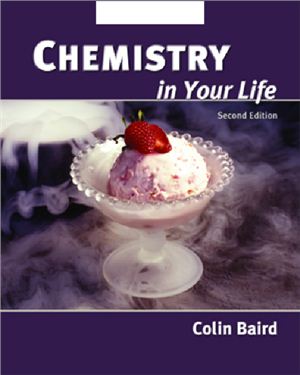2nd Edition - W. H. Freeman, 2006. - 750 pages.
Chemistry in Your Life is designed for liberal arts students who are required to take a science course, but do not necessarily have a strong background in chemistry or science. The book ties every chemistry concept to things familiar to students - nutrition, drugs, the environment, household items. Rather than wait until the end of the text to apply chemistry to relavant topics, Chemistry In Your Life integrates the applications from the first chapter, providing students with interesting reasons to lea the concepts, and better analogies to understand them.
The Elemental Foundation of Chemistry: Atoms, Molecules, Elements,Compounds, Mixtures, and States of Matter
New Identities? Physical and Chemical Change
An Insider’s Perspective: The Inteal Workings of Atoms and Molecules
Powering the Planet: Hydrocarbons and Fossil Fuels
From Diamonds to Plastics: Carbon’s Elemental Forms, Addition Polymers, and Substituted Hydrocarbons
The Flavor of Our World: The Oxygen-Containing Organic Compounds We Drink, Smell, and Taste
Health and Energy: Carbohydrates, Fats, and Oils
Condensation Polymers, Especially Those Containing Nitrogen: The Chemistry of Medication and Clothing
The Molecules That Make You What You Are: Nucleic Acids, Proteins, and Hormones
Chemicals in Our Bodies and Our Environment: Vitamins, Food Additives, Pesticides, and More
Chemistry in Water: Salts, Acids, and Bases
Batteries, Fuel Cells, and the Hydrogen Economy: Oxidation and Reduction
Fit to Drink: Water: Sources, Pollution, and Purification
Dirty Air, Dirty Lungs: Air Pollution
Stratospheric Chemistry and the Ozone Layer: A Thin Veil of Protection
Global Warming and the Greenhouse Effect
Radioactivity, Nuclear Energy, and Solar Energy: The Core of Matter
Chemistry in Your Life is designed for liberal arts students who are required to take a science course, but do not necessarily have a strong background in chemistry or science. The book ties every chemistry concept to things familiar to students - nutrition, drugs, the environment, household items. Rather than wait until the end of the text to apply chemistry to relavant topics, Chemistry In Your Life integrates the applications from the first chapter, providing students with interesting reasons to lea the concepts, and better analogies to understand them.
The Elemental Foundation of Chemistry: Atoms, Molecules, Elements,Compounds, Mixtures, and States of Matter
New Identities? Physical and Chemical Change
An Insider’s Perspective: The Inteal Workings of Atoms and Molecules
Powering the Planet: Hydrocarbons and Fossil Fuels
From Diamonds to Plastics: Carbon’s Elemental Forms, Addition Polymers, and Substituted Hydrocarbons
The Flavor of Our World: The Oxygen-Containing Organic Compounds We Drink, Smell, and Taste
Health and Energy: Carbohydrates, Fats, and Oils
Condensation Polymers, Especially Those Containing Nitrogen: The Chemistry of Medication and Clothing
The Molecules That Make You What You Are: Nucleic Acids, Proteins, and Hormones
Chemicals in Our Bodies and Our Environment: Vitamins, Food Additives, Pesticides, and More
Chemistry in Water: Salts, Acids, and Bases
Batteries, Fuel Cells, and the Hydrogen Economy: Oxidation and Reduction
Fit to Drink: Water: Sources, Pollution, and Purification
Dirty Air, Dirty Lungs: Air Pollution
Stratospheric Chemistry and the Ozone Layer: A Thin Veil of Protection
Global Warming and the Greenhouse Effect
Radioactivity, Nuclear Energy, and Solar Energy: The Core of Matter

